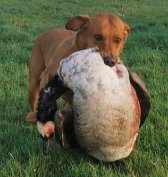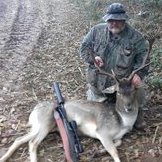
Ajarrett
Members-
Posts
157 -
Joined
-
Last visited
-
My latest book is now available. A new book on pigeon and corvid control. Chapters on stubble shooting, drilled crops, flighting, corvid control, sport abroad, gaining permission to shoot, and much more Message me for details on availability Price £25.00 postage paid
-
Never used curlew decoys, but used to use the dog in September to dupe them. By sitting the dog up in the open and hiding in an adjacent creek the curlew would come to mob the dog. Constant calling and complaining from the birds as they circled was great to observe, and when they came within range that was it. On a good day it was possible to get several like that - with the young birds particularly susceptible to this ruse. Golden plover are fine to eat, and tremendous sport. They can be easy to call, especially if its foggy, and decoy well if you can get on the marsh they are feeding on.
-
Wader shooting was a good way of learning our wildfowling 'trade' back in the day. I used to have some cracking tide flights, allowing me to stay out all day when the tides where middle of the day. Morning flight for duck (few and far between it seemed) the the flood tide for waders along the salting edge until flooded out; then the ebb when the waders would come thick and fast as the tide dropped. Followed by evening flight for duck. Redshank, bar-tailed godwits, grey plover, whimbrel and curlew all breasted for the freezer until there were enough to make a big wader pie. On really windy days it was possible to walk the saltings for redshank and grey plover, flushing them from the creeks where they were hunkered down.. Medway Estuary grey plover were pretty vile, but still went into the pie just the same! Towards the end of the '70s I had my two record flights of curlew - both on the Isle of Sheppey. Great shooting as they came out of the freshmarshes on the ebb. The ban on shooting them was probably timely in hindsight, as we do not see them in the numbers there used to be. Still we have those memories! Subsequently I found a fantastic curlew flighting spot in the moonlight on the flooding tide, and could have really bagged up if I wanted had they still been on the list. Happy days!
-
ehb102 - Two Cambridgeshire clubs actually Ely with whom we share some shooting rights. Also CFSA, with whom we are 50:50 owners of freehold on one of the washes. Good working relationship also with Fenland
-
Seems like you have put a lot of trust in RSPB for the future of wildfowling on coastal marshes and reserves? How many of their "reserves" have been opened for use and access by wildfowlers? Quite the reverse Harkom. Happy to do business with them, and benefit financially and with any good PR as well. But only where we own the land and have control. We all know how much damage is being done to the sport and which organisations are responsible. The answer to that last question would be "none that I'm aware of; and not holding my breath on that!"
-
Part of the diversification work being done by Kent - drawing down funding by working with others to carry out conservation work. Even with the RSPB! Media release RSPB launches major new wetland restoration programme in Southeast England • The Species Coastal and Wetlands Programme will restore and create vital habitats at landscape-scale, for the benefit of multiple threatened species including Lapwing, Redshank, Crane, Bittern, Water Vole and Common Tern. • The UK has lost 90% of its wetlands in the past 100 years. • Now covering just 3% of the UK, wetland and freshwater habitats are still home to 10% of our native species. • Work is taking place at over ten sites from the Solent to the Norfolk Broads. • The programme will also offer 900 ‘nature prescriptions’ by training practitioners at Rainham and Dungeness. • The programme is funded by the UK Government’s Species Survival Fund. • It is a partnership between RSPB, The Prince’s Trust, The Church Commissioners for England, Kent Wildfowling and Conservation Association, and private landowners. Wallasea, RSPB Reserve, 2019, (David Wootton - RSPB-Images)---- The RSPB has launched a major coastal and wetland restoration programme across Southeast England. Over the next 18 months, work is taking place at a range of sites from the Solent to the Norfolk Broads, to enhance habitat at landscape-scale for threatened species including Lapwing, Redshank, Bittern, and Water Vole. The programme is funded by the Species Survival Fund, a partnership between Defra and National Lottery Heritage Fund to support projects which create and restore habitats to help reverse the decline of species. This is part of the Government’s legally binding commitment to halt the decline in species abundance in England by 2030. ‘Species Coastal and Wetlands’ will restore and create 246ha of grazing marsh, 7,500m2 of saline lagoons, 4ha of reedbeds, and 0.5ha of vegetated islands. Other capital works will include the creation of seasonal pools for waders, tunnels and barriers to manage water, nesting rafts for breeding terns, and the restoration of rare, vegetated shingle. The result will be that these habitats are ‘more, bigger, better, joined’, in line with the Lawton Principles. The programme will run from August 2024 until February 2026. With threatened wetland species like Lapwing and Redshank continuing to decline and now absent from many former breeding areas in Southeast England, landscape-scale restoration is an urgent conservation priority. Water Voles have also declined by as much as 90% across Britain. This is in part because the UK has lost 90% of its wetlands in the past 100 years. Today covering just 3% of the country, freshwater and wetland habitats are still home to 10% of all UK species. By restoring these habitats along England’s Southeastern coastline, the programme will not only benefit UK wildlife, but the millions of migratory birds which traverse the East Atlantic Flyway every year. Much of the work will take place at RSPB reserves, but the programme will also work with private landowners to enhance habitat and safeguard low-lying landscapes against droughts and rising sea levels. This will be achieved through a range of actions, including the installation of solar pumps to better manage groundwater. Mike Shurmer, Head of Species for England at RSPB, said, “Habitat loss and degradation is one of the leading causes of the UK’s steep decline in biodiversity, with many threatened species restricted to small, disconnected areas of habitat. The Species and Coastal Wetlands programme is a major effort to restore, enlarge, and reconnect crucial habitats in landscapes including the Greater Thames, Suffolk Coast and Norfolk Broads. This work will help to relieve the pressure on some of the UK’s most threatened species, and to better protect the habitats upon which they depend. With nature in crisis, it is vital that we act quickly and at a landscape-scale to conserve and restore our precious wetland habitats which support one in ten UK species”. Beyond direct interventions in the landscape, the programme will seek to engage communities in some of the most deprived wards in Southeast England, working with 40 young people who are not in education, employment or training, creating two apprenticeships, and offering four Get Started in Conservation programmes in partnership with The Prince’s Trust. Following the RSPB’s successful delivery of ‘nature prescriptions’ with NHS Scotland, the programme will help pioneer this approach to improving people’s wellbeing in England. In essence, nature prescriptions mean prescribing nature to patients with both mental and physical difficulties. During its two-year lifespan, the programme will train 30 prescribers and offer 900 such prescriptions in Rainham and Dungeness. Robbie Brett, Environmental Asset Manager within the Farmland team at the Church Commissioners for England, said, “We are proud to work together with the RSPB on this transformative project, harnessing the potential of our land and securing funding to enhance and restore sensitive habitats alongside sustainable food production. Home to a number of nationally significant wildlife sites, this collaborative effort across the Southeast will address an urgent need to create healthy habitats at the scale required for species at risk to recover and thrive.” Species Coastal and Wetlands is a partnership between RSPB, The Prince’s Trust, The Church Commissioners for England, Kent Wildfowling and Conservation Association and private landowners. To find out more about the Species Survival Fund, please visit: https://www.heritagefund.org.uk/publications/faqs-species-survival-fund
-
Not tetchy! Just thought it was worth clarifying. LOSWA as a small club are doing a great job in managing our land in Essex. Mainly because they have strong leadership, and clear vision. World domination? I'll settle for the East Coast for now! 😄
-
Leigh? (only going off your location - I'm just up the road). Thought they were in cahoots with Kent? Keith is Canvey I believe. Leigh is not 'in cahoots' with Kent. LOSWA merged with Kent in 2011 and is an important contributor in what we do as we expand our club offer. We also have shooting agreements with clubs at Chichester, Cambridge and Ely. I'm afraid Kent gave up holding social meetings some while ago due to poor attendance. Even our last meeting, which was important as we were setting up corporate trustees and changing our constitution, was poorly attended. We reached the conclusion long ago if we were to continue to thrive and grow - thereby protecting the sport we love - we would have to diversify our offer. That is why we now offer fishing, rough shooting, and air rifle hunting. We acquired a major carp fishery three years ago, which more than doubled our membership at a stroke. Club wildfowling membership continues to thrive, partly no doubt because of the breadth of our offer across five counties. Whilst still taking new members membership currently stands at 565. Add in all the other categories we are at 1,465. Whilst hard-core wildfowling continues as the core offer at Kent, our diversification is for us the key to growth. More land = more members = more cash = more land ............. Clubs joining together where appropriate and palatable is one way of securing our sport for the future. Super clubs? Not for me to say! A step too far for many Alan
-
Without wanting to start a row, please someone remind me the basis in law for NE creating a 300 mtr buffer zone (which is an extension) around SSSIs. I didn't see that being challenged, which - suitably emboldened - then lead to them imposing a 500 mtr buffer zone.
-
Just interested!
-
Are you affiliated to BASC?
-
This is really positive news. In my opinion we can trace much of the current discontent back to when wildfowlers effectively lost control of Council by failing to get wildfowlers elected in the period up to 2015. Perhaps time to awaken a sleeping giant. Alan
-
Another two joiners yesterday taking us to 1,560. Looking forward to renewals and new joiners from 1st April to see if we can maintain that growth
-
BASC lifts call for restraint on shooting waterfowl across UK
Ajarrett replied to Conor O'Gorman's topic in Wildfowling
The change is from snow-covered or frozen ground, to frozen grass and air temperature. Apparently nobody at BASC knows when the change happened our who agreed it! -
BASC lifts call for restraint on shooting waterfowl across UK
Ajarrett replied to Conor O'Gorman's topic in Wildfowling
Be interesting for Conor to explain what BASC's role was in the tightening of the criteria by which a wildfowling suspension can brought to bear. When we challenged SE Region they didn't seem to know there had been a change - or indeed what it originally was! 'It used to be snow-covered or frozen ground'




